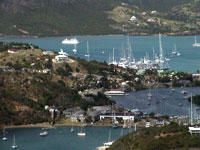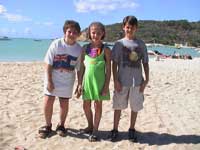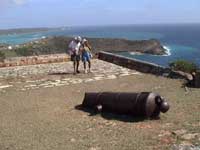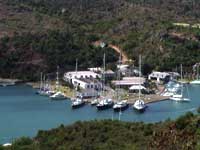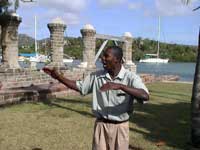
When the Caribbean Explorer returned to Philipsburg, we got on a plane and flew south to Antigua (about a 25-minute flight by jet plane). We’re now on our next expedition ship, the Nantucket Clipper. This ship is 207 feet long, 47 feet wide, and powered by two 500 horsepower diesel engines. It has a crew of 37 and can carry 104 passengers. While on the Nantucket Clipper we’ll be exploring the Leeward Caribbean islands – on land and underwater – to learn about the history, nature, and culture of these islands. Some kids from the United States are joining us for our first week on the Nantucket Clipper. They’ll be exploring with us. The oldest is Matt, from Hudson, Ohio. Matt will celebrate his thirteenth birthday during our expedition. The youngest is Lauren, from Gainesville, Georgia. Lauren is seven years old. These kids are here with their parents exploring the Caribbean islands for a week during Christmas vacation. We’re working on the Nantucket Clipper as marine biologists, telling people about what they’ll see underwater. While in Antigua, our ship is anchored near England's former Caribbean naval base. During the American Revolution, England had the strongest navy in the world. England was competing with Spain, France, and Portugal for Caribbean islands where valuable sugar and spices were grown. To help protect English Caribbean islands from other countries and pirates, England set up a large navy base in Antigua. This base was started in 1725 and closed in 1889. It has been restored so we’re exploring to see what it was like it 200 years ago. After the American Revolution, British Admiral Horatio Nelson (then Captain Nelson) was sent to Antigua to take command of the British naval fleet headquarters here. His job was to prevent England’s former American Colonies from trading (buying and selling) with English Caribbean islands. Americans wanted to buy sugar, cotton, spices, and tobacco from these Caribbean islands, but the British navy would capture or sink any American ships it caught trading with the islands. The Caribbean plantation owners wanted to trade with the Americans, so they didn’t like Captain Nelson stopping them. After three years here, Captain Nelson was sent back to England where are became a famous British sea captain and was made an Admiral. Today this old British navy base is called Nelson’s Dockyard in honor of Admiral Nelson. Visitors can learn about life during the American Revolution by viewing the types of things people wore, ate and even drank, because many of these things came from Caribbean islands. If the Americans could avoid the British navy, and people like Captain Nelson, it was easier and cheaper to buy things directly from the Caribbean islands than to buy them from England. We’re just glad there’s peace between the United States and England today so we can visit this island and buy things without being arrested! Tomorrow we are taking a Christmas break onboard the Nantucket Clipper, then we will be back with you the day after Christmas. Merry Christmas to All! - Mrs. & Mrs. Brown |
English Harbor, Antigua, as viewed from an old British fort. Our ship, the Nantucket Clipper, is near the top of the picture. Nelson’s Dockyard is the group of buildings at the bottom of the picture. British forts with cannons at the harbor entrance and on the surrounding hills once protected the dockyard.
Here are some of our friends we met on the expedition. Left to right: Matthew, 13 years old this week; Matthew's sister, Bethany, 10 years old; and Fredrick, 10 years old.
Some tourists look out over the Caribbean Sea from one of the British forts that protected Nelson’s Dockyard. One of the old cannons is lying on the ground with its end broken off.
Nelson’s Dockyard. The buildings with the gray roofs are the actual headquarters of the British navy. Two hundred years ago, British sailing warships moored where the sailing yachts are tied up today.
Our Antiguan guide, Emanuel, tells us about the history of Nelson’s Dockyard and how people lived during the days of the American Revolution. |
|||||||||||||||||||||
|
||||||
